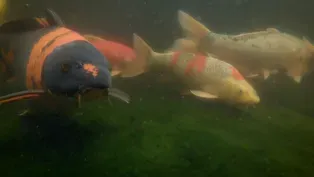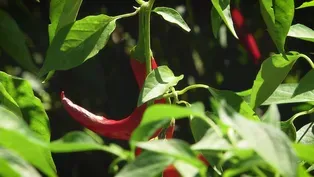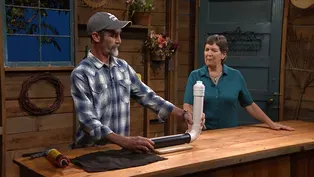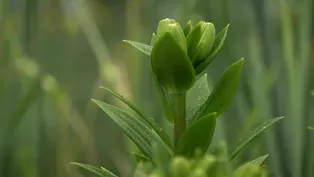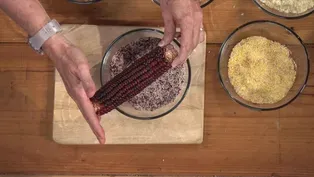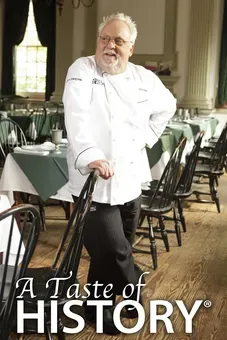Virginia Home Grown
Grist Mills
Clip: Season 23 Episode 3 | 8m 39sVideo has Closed Captions
Discover how the power of water is used to process grain
Robyn Puffenbarger tours Wade’s Mill in Rockbridge County, Virginia’s oldest operating grist mill, with owners Karen and John Seigfried, to see how water power was used to process corn and other grains, and learn about the history of milling in Virginia’s Shenandoah Valley. Featured on VHG episode 2303; May 2023.
Problems with Closed Captions? Closed Captioning Feedback
Problems with Closed Captions? Closed Captioning Feedback
Virginia Home Grown is a local public television program presented by VPM
Virginia Home Grown
Grist Mills
Clip: Season 23 Episode 3 | 8m 39sVideo has Closed Captions
Robyn Puffenbarger tours Wade’s Mill in Rockbridge County, Virginia’s oldest operating grist mill, with owners Karen and John Seigfried, to see how water power was used to process corn and other grains, and learn about the history of milling in Virginia’s Shenandoah Valley. Featured on VHG episode 2303; May 2023.
Problems with Closed Captions? Closed Captioning Feedback
How to Watch Virginia Home Grown
Virginia Home Grown is available to stream on pbs.org and the free PBS App, available on iPhone, Apple TV, Android TV, Android smartphones, Amazon Fire TV, Amazon Fire Tablet, Roku, Samsung Smart TV, and Vizio.
Providing Support for PBS.org
Learn Moreabout PBS online sponsorship(water gushing) (mill creaking) (mill whirring) (water gushing) (water gushing) >>Karen, I know Wade's Mill from my time in graduate school and visiting here in the mid-90s.
But I understand the mill is much older than that.
>>Yes, Robyn, there's been a mill on site since 1750.
And so Wade's Mill is one of the oldest commercial grist mills in Virginia if not the oldest, and one of the oldest in the US.
>>As we're standing here looking at the water coming over, I think it didn't always come in just like this.
>>Right.
So originally, there would've been a long wooden mill race going all the way back to the edge of the property but as you can imagine, a long wooden box full of water the entire time was very hard to maintain.
So in the early '30s, iron pipe was installed and that's how the water gets to the mill.
>>Now would that be the 1930s or the 1830s?
>>The 1930s.
The 1930s.
>>When you're looking at preserving a property from the 1750s, I'm guessing things are not the same.
It's more than just the water that's changed over hundreds of years.
>>Right.
Well, originally, the mill was three stories and then in the late 1700s when they installed the Oliver Evans system which was US patent number three as a way of moving material around the mill, the fourth floor was added.
So that was a change from the original structure.
But the foundation that you see, the limestone is the original from the 1750s and much of the interior.
A lot of the beams are the original beans from the 1750s.
>>And so the original miller, how far would people be bringing the grain to them?
>>Originally, the mill would've served the local farming community and the majority of the milling would've been done for animal feed, to feed the farmers animals and a bit for the human consumption for the farmer's family.
>>And then it sounds like things changed from the late 1700s into the mid-1800s.
>>Right.
And once that system, the Oliver Evans system was installed in the mill, the miller could then become more of a merchant mill and could buy in grain to mill and then send packed in barrels by river out to the eastern seaboard and then abroad.
>>So we are talking about flour from Virginia in the late 1700s, mid-1800s going international.
>>Internationally, as far as Brazil.
>>Wow.
When we're thinking about the history of the mill, we get to the 1850s and there's something else famous going on just down the road.
That's right.
>>So up until that point, the Shenandoah Valley was considered the Bread Basket of America.
And then Cyrus McCormick came along at his farm just up the road and invented the Reaper.
And so once the Reaper was around, it didn't really work that well on the landscape of the hilly landscape of the Shenandoah Valley.
So Cyrus McCormick moved his business to Chicago and the rest is history.
The Midwest became the grain belt of America as it still is today.
>>But you're still here.
>>But we're still here.
One of the few mills still standing.
>>Wow.
Well thank you, Karen, so much for all this history as we watch the waterwheel go around.
Now, we're going to go inside the mill and I think someone else is gonna give us a special tour.
>>That's right.
You'll be meeting my husband, John, the miller.
(water gushing) >>So John, what now is working with the water power from the wheel outside?
>>So water power still comes into the operation.
I still use it for lifting my heaviest sacks of grain up the side of the building.
So all of my grain is stored upstairs.
All of the milling is done here.
In the 1980s, the Wade family installed two sets of electric stones.
And so everything is stone ground but done with two sets of electric stones.
>>So it sounds like US patent number three of the 10 million that have been granted in the US is a very important number for you.
>>It's an important number for a lot of the mills that were built between 1750 and 1850.
It was a patent signed by George Washington.
It was a patent developed by Oliver Evans and it was the most efficient way to organize a grist mill with the power plant downstairs milling and packing on this floor and separating or sifting on the floor above and then storage of the grain and cleaning.
So you're constantly shifting material up and then using gravity to help you separate out big things from little things.
>>And so before patent number three, that would've been all human powered?
>>Yes.
Efficiency, there's always a cost to that or you're working toward trying to reduce the number of people that are in many cases, exposed to safety issues.
Mills can be dangerous things.
There's belts, pulleys turnings.
So the fewer people that you had in the mill, the safer it was, but also the more efficient.
>>As we were talking about outside, Virginia once was a bread basket.
So how would this mill have contributed to having food not just for Virginia, but maybe farther afield?
>>Yeah, so once you could separate, once you could remove bran and germ from white flour, then you had a commodity.
So that was the early 1800s.
But then by 1850, Mr. McCormick just up the road developed the Reaper in that industrialized agriculture.
And he very quickly moved to Chicago.
And then it was a long slow decline.
The Wade family bought the mill in 1880 and upgraded it.
So a lot of the equipment that we run on weekends goes back to the 1880s.
We run that and we run the water wheel so people can kinda see how a mill ran in the 1880s.
Businesses were always trying to improve their business and make them run but the writing was on the wall.
It was far more efficient to farm in the Midwest.
And by 1850, you had rails so you had distribution then.
>>So then, how do you come into the picture now?
'Cause we're in the 2020s and so much later than 1880.
>>Yeah, probably even since I left university, there's been a slow and growing community of people that wanna know where their food has come from.
They want stone ground grains.
There's actually an organization in Virginia that is trying to get grain production back to Virginia.
It's called the Common Grain Alliance.
It's an alliance that connects farmers to millers to bakers.
And so that has also helped.
It's helped us be able to connect to farmers because we're not ag people originally.
But if you're interested, you can learn to do anything.
And we've slowly now have a network of farmers, local farmers that grow for us and local bakers that use our product.
>>So what kinds of products would you produce nowadays?
>>Most of our raw material is sourced locally.
We grind five kinds of corn, three kinds of wheat, depending on what kind of baker you are.
Spelt, rye, buckwheat.
Most of it's grown between Southern Pennsylvania and North Carolina.
>>Wow.
John, thank you for all of this information.
This is just a wonderful place to come and visit >>Anytime.
Happy to have you.
Video has Closed Captions
Discover uses for water in gardening and agriculture beyond sustaining plants! (26m 46s)
Video has Closed Captions
How to build a water feature that meets the goals for your landscape (4m 54s)
Video has Closed Captions
Learn how to harvest and store rainwater safely (3m 12s)
Video has Closed Captions
Learn about the products millers create from corn and wheat (6m 12s)
Providing Support for PBS.org
Learn Moreabout PBS online sponsorshipSupport for PBS provided by:
Virginia Home Grown is a local public television program presented by VPM

